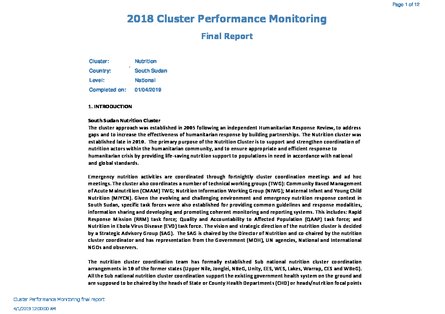
The cluster approach was established in 2005 following an independent Humanitarian Response Review, to address gaps and to increase the effectiveness of humanitarian response by building partnerships. The Nutrition cluster was established late in 2010. The primary purpose of the Nutrition Cluster is to support and strengthen coordination of nutrition actors within the humanitarian community, and to ensure appropriate and efficient response to humanitarian crisis by providing life-saving nutrition support to populations in need in accordance with national and global standards.
Emergency nutrition activities are coordinated through fortnightly cluster coordination meetings and ad hoc meetings. The cluster also coordinates a number of technical working groups (TWG): Community Based Management of Acute Malnutrition (CMAM) TWG; Nutrition Information Working Group (NIWG); Maternal Infant and Young Child Nutrition (MIYCN). Given the evolving and challenging environment and emergency nutrition response context in South Sudan, specific task forces were also established for providing common guidelines and response modalities, information sharing and developing and promoting coherent monitoring and reporting systems. This includes: Rapid Response Mission (RRM) task force; Quality and Accountability to Affected Population (QAAP) task force; and Nutrition in Ebola Virus Disease (EVD) task force. The vision and strategic direction of the nutrition cluster is decided by a Strategic Advisory Group (SAG). The SAG is chaired by the Director of Nutrition and co-chaired by the nutrition cluster coordinator and has representation from the Government (MOH), UN agencies, National and International NGOs and observers.
The nutrition cluster coordination team has formally established Sub national nutrition cluster coordination arrangements in 10 of the former states (Upper Nile, Jonglei, NBeG, Unity, EES, WES, Lakes, Warrap, CES and WBeG).
All the Sub national nutrition cluster coordination support the existing government health system on the ground and are supposed to be chaired by the heads of State or County Health Departments (CHD) or heads/nutrition focal points in the State and sub states. The composition of the State level coordination mechanisms is similar to that at Juba depending on the number of operational partners on the ground.
